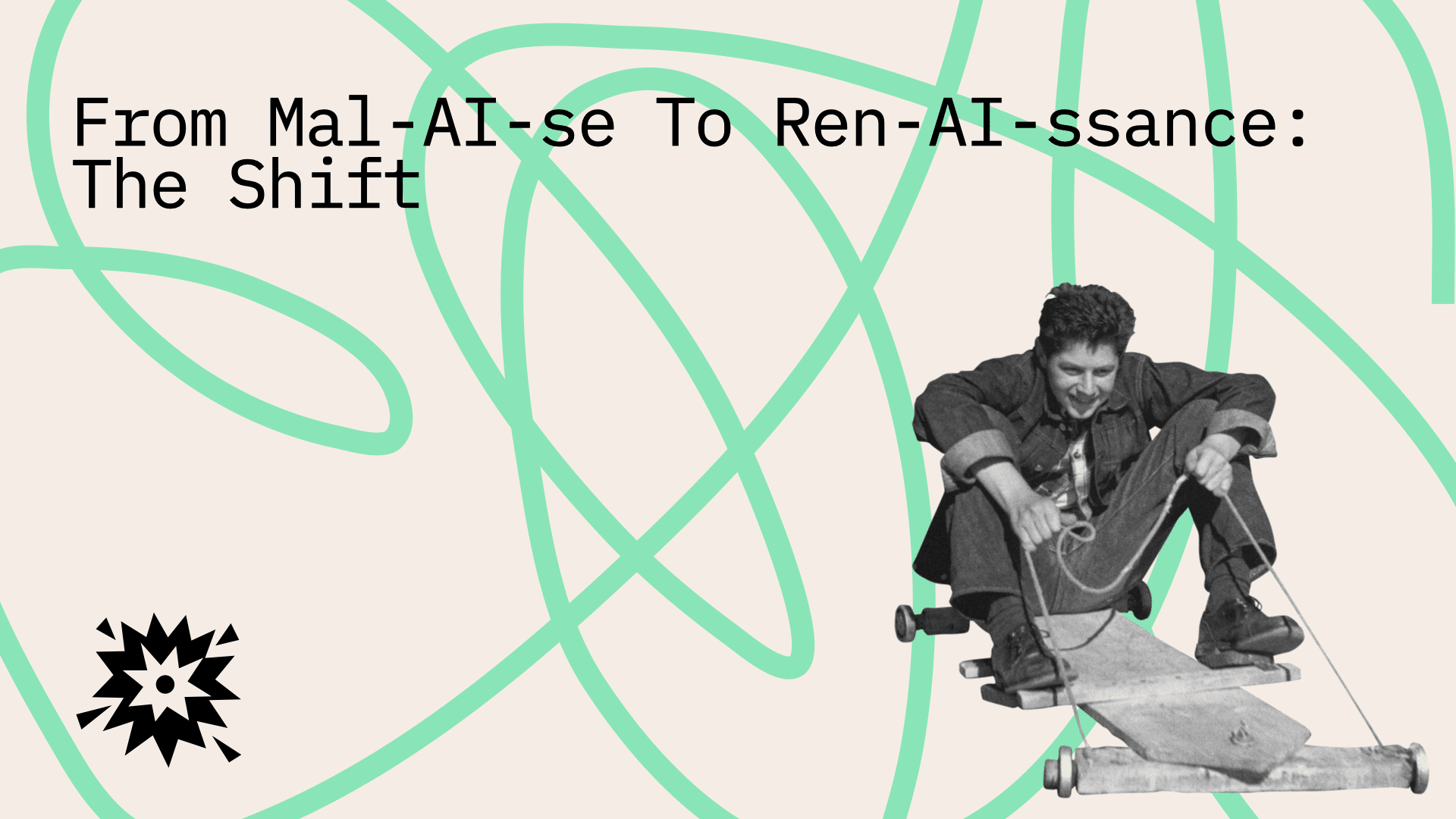This post is based on a talk I delivered at Freelance Unlocked in Berlin. You can watch the full 33-minute presentation here or read the key insights below.
If you’re a founder, entrepreneur, or creative professional, you’ve probably felt it. That nagging sense that the rules of business are changing faster than you can adapt. That what got you here won’t get you there. That maybe your expertise isn’t as valuable as it used to be.
You’re not imagining it. We’re in the middle of the biggest professional upheaval since the Industrial Revolution. But here’s what most people are getting wrong: this isn’t just about technology. It’s about identity, meaning, and how you define success in a world where machines can outproduce you.
The question isn’t whether your work will change. It’s whether you’ll be ready for what comes next.
The Future Is Already Here
Let me start with some perspective. William Gibson coined the term cyberspace and famously said: “The future is already here, it’s just not evenly distributed.”
Rather than diving into all the technicalities of AI, I want you to imagine something with me. Imagine we have what they’ve been promising us—tools that are as smart as human beings, maybe smarter, that we can deploy at scale and economically.
I understand I’m asking you for a lot, but let’s imagine the future is already here.
The Cave We Fear to Enter
Joseph Campbell understood something fundamental about transformation: “The cave you fear to enter holds the treasure you seek.” To transition from malaise to Renaissance, we need to enter a cave—one we’ve been avoiding. But in that cave lies exactly what we need.
Why do we need to enter this cave? Because here’s what’s really happening, and why it matters to your career, your business, your sense of professional identity:
We were presented with a narrative around AI and automation that said menial jobs would be replaced first. Factory work, truckers would be replaced.
Instead, the robots came for the creatives. They came for the poets.
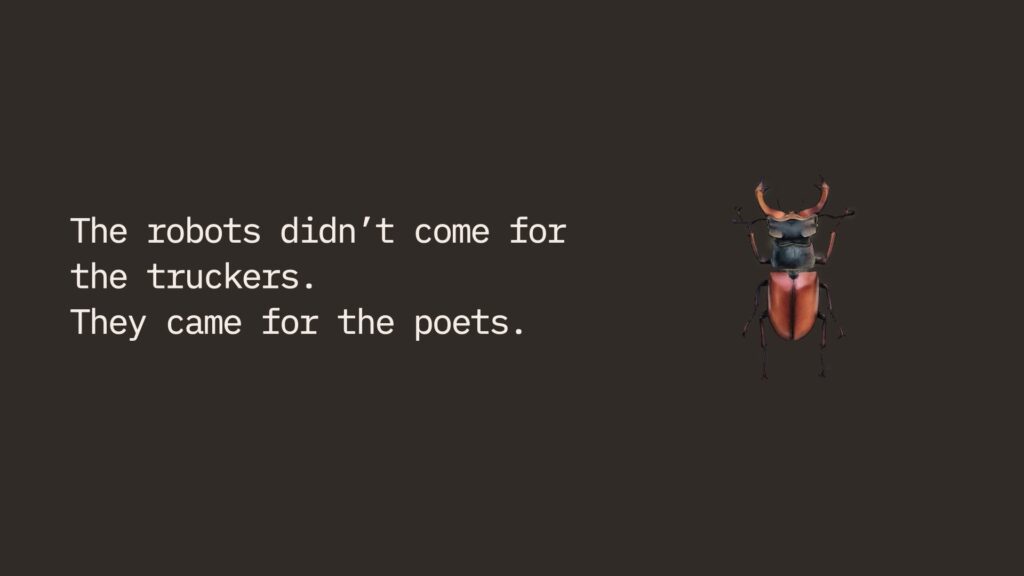
This isn’t just a quirky observation. This is your reality. If you’re reading this, you’re probably someone whose value comes from producing, creating, making. Your expertise, your unique perspective, your ability to solve problems—that’s what’s under threat.
The Malaise We’re All Feeling
This gives us a sense of malaise—”a general feeling of discomfort, illness, or unease whose exact cause is difficult to identify.”
I recently asked a room full of entrepreneurs and freelancers: “Who here feels their job is going to change pretty radically very soon?”
80-90% of hands went up.
“Who feels scared about it?”
Just 5%.
We’re optimists. But there’s still this underlying unease. You feel it in those 3 AM moments when you wonder if your skills will matter in two years. You feel it when you see AI doing tasks that took you years to master. You feel it when clients start asking why they should pay your rates when there’s a tool that can do it for $20 a month.
That’s malaise. And if you don’t address it, it becomes paralysis.
Our Maps Are Broken
The issue is simple: our current maps suck. Badly.
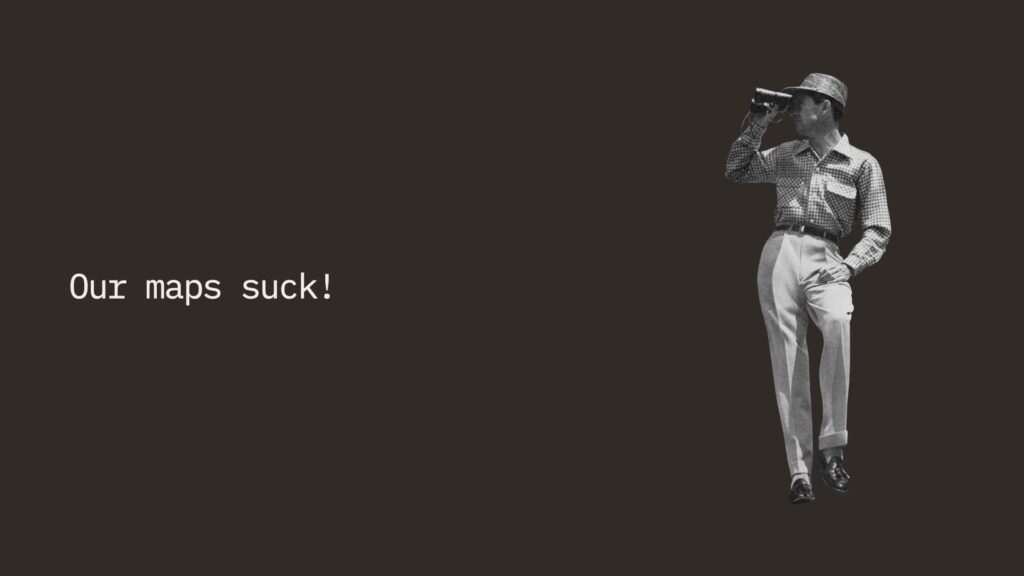
Here’s what this means for your career: The longitudinal career path—work your way up, build expertise, become indispensable—was already in trouble. What’s happening now will put it in the ICU.
Companies are going after entire job descriptions. CaseText (now called CoCounsel after being acquired by Thomson Reuters) analyzed paralegals and created the perfect AI substitute. In gaming, massive layoffs hit the creatives first because companies realized they could train AI to do environment design and NPC creation.
CTOs I talk with are still hiring developers, but not junior ones. They prefer training AI. If you’re early in your career, the traditional path of starting junior and working up may not exist anymore.
If you’re senior, your value isn’t your ability to execute—it’s your ability to think, decide, and guide.
The Lens That Changes Everything
I want to give you a lens that might offer hope. But remember—we have to go through that cave.
The lens is this: we’re all experiencing a forced midlife crisis.
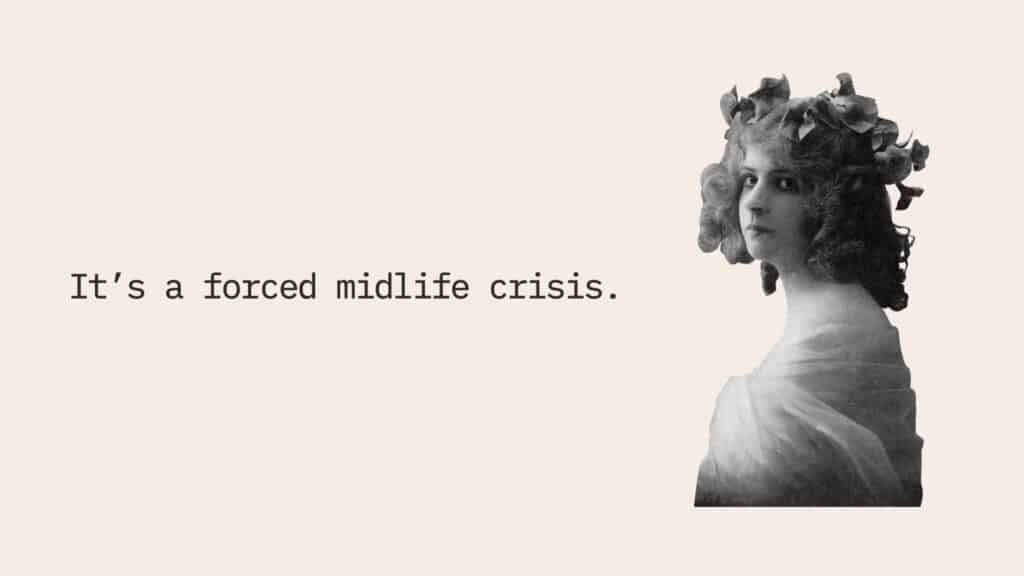
The kind where you buy a sports car. A crisis of meaning. When AI has all the answers, what’s your role? When machines can outproduce you, what makes you valuable?
This lens can help you bridge the gap between malaise and Renaissance. Because like any midlife crisis, this is fundamentally about rediscovering who you are when the external markers of success shift.
I can talk about midlife crises because in 29 years of working, I’ve changed careers eight times. I’ve had at least four or five midlife crises. And, I drive a car that screams midlife crisis: a Porsche.
The Death of Hustle Culture
This shift has casualties. The first casualty is—for me, at least—a welcome one: hustle culture is over.
Here’s why this matters to you personally: You’ve probably built your professional identity around your output. Part of who you are is tied to what you produce, how much you can handle, how fast you can deliver.
I just gave you something that’s more capable than you at outputting, creating, generating. What does that leave you with?
An existential crisis.
Hustle culture stems from the Industrial Revolution. It’s the ideology that more is better—more work, later hours, more Red Bull. When we had problems, we could double down, do more, power through. It was an easy answer.
But when I give you technology that’s better than you at output, what do you do? If production and productivity were your North Star, what’s the new North Star?
The new North Star is thinking, reflecting, slowing down, observing, strategizing, philosophizing.
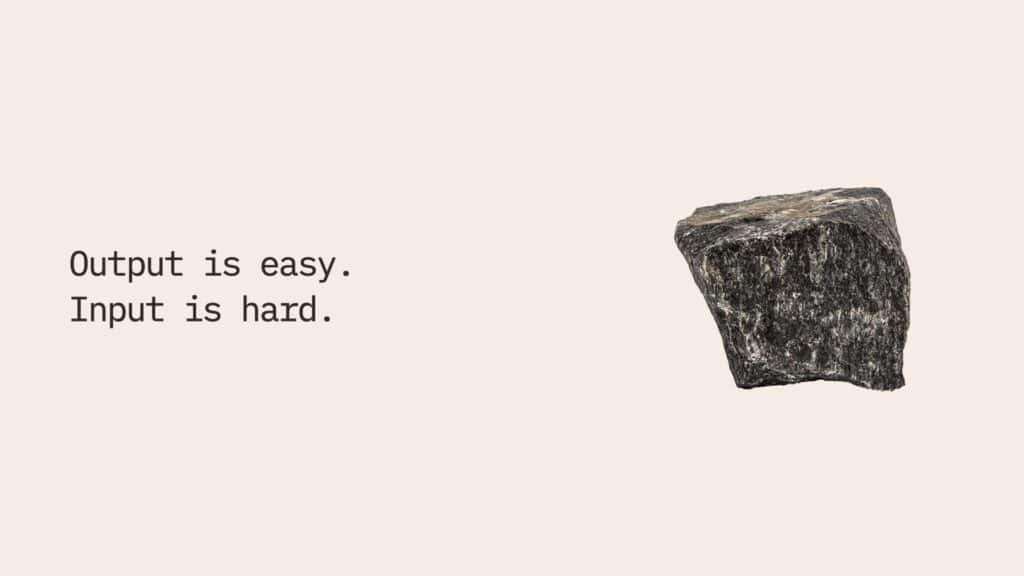
Here’s the hard truth: We’re going from a world that’s much simpler to one that’s much harder. From focusing on raw output to refined input. And thinking, compared to output, is so much harder.
This means if your competitive advantage was working faster or longer than everyone else, you need a new competitive advantage.
Frameworks Become Prompts
Another casualty: frameworks, systems, playbooks. The step-by-step approaches that built entire industries.
Don’t get me wrong—I love frameworks. But here’s what’s happening to your business: If something can be boiled down to step-by-step instructions, isn’t that just a prompt for AI?
If you can explain your process to a language model, why would a client hire you to do it?
Frameworks will continue to exist, but they won’t have the same value. AI will execute the frameworks. What does that leave you with?
Principles. Unchanging laws of physics, psychology, behavioral economics, markets. The why behind the what.
If you’ve built your expertise around following processes, you need to shift to understanding principles. If you’ve positioned yourself as someone who executes systems well, you need to reposition as someone who creates systems.
The Outside-In Trap
Let me show you something that illustrates our problem. This is my YouTube dashboard:
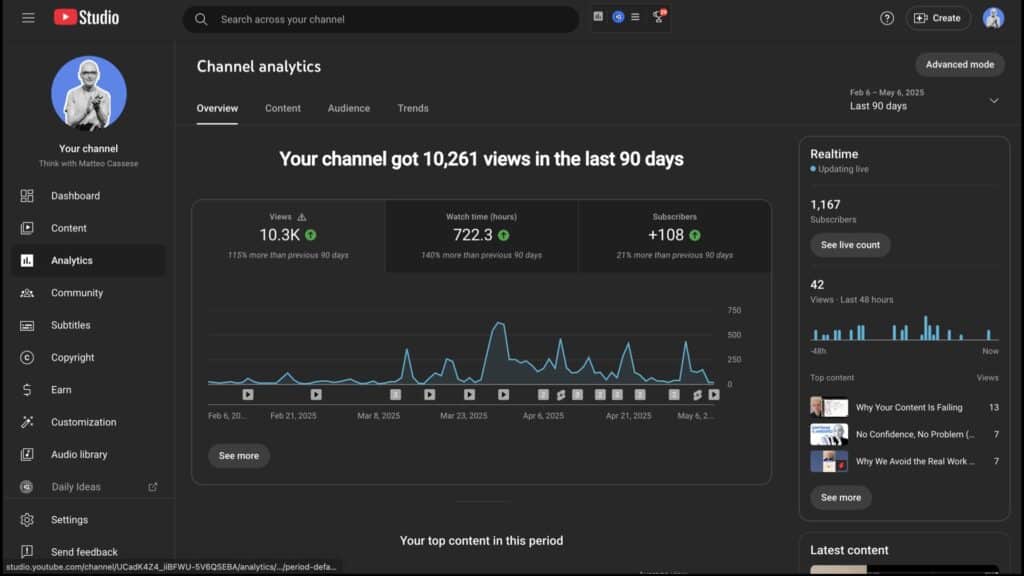
My goal with my channel is to touch the hearts and souls of 3, 4, 5 people every month. That would be a grand result.
But what does the platform present me with? A dashboard of numbers constantly updated, perfectly gamified so my monkey brain can publish a video and hit refresh. Real-time analytics, green arrows going up.
That’s a horrible use of my brain. I’m accepting to become reactive rather than creative.
Here’s what this means for your business: We’re so used to working outside-in because it’s easier. You wake up, check emails—suddenly you have a to-do list from people outside of you. They establish what you do.
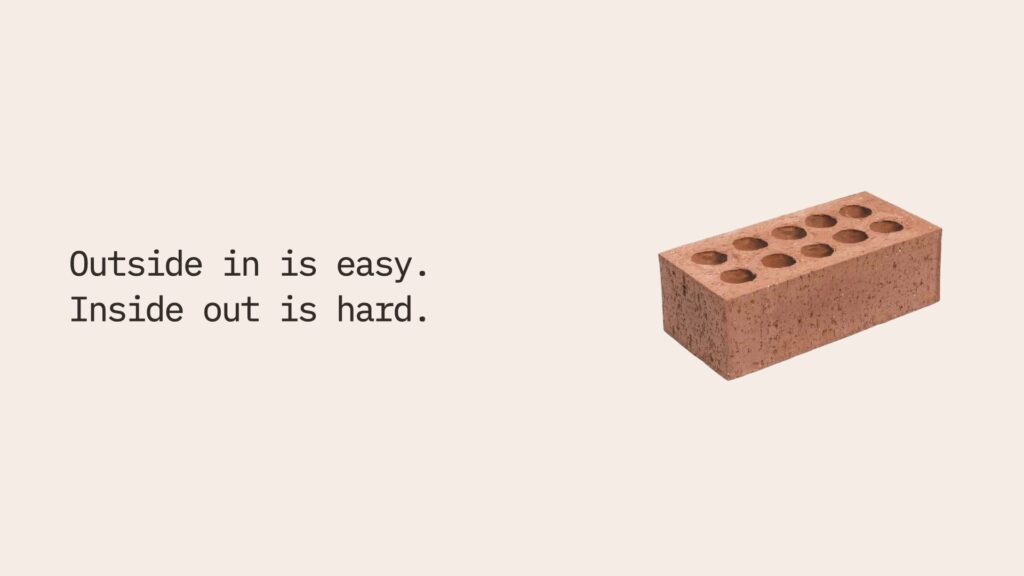
But working from inside-out is way harder. It requires knowing your internal motivation, your why, your intuition. And most of us have no idea what that even means anymore.
The cave we fear to enter is this question: What is your internal motivation? Why do you do what you do? What’s inside of you that’s uniquely yours?
If you don’t know the answer, you’ll keep being reactive to external demands instead of creating from your authentic center.
No Maps, Only Mapmaking
We lost the maps. If you ask me what the new map is, I’ll tell you there’s no map. But there is mapmaking.
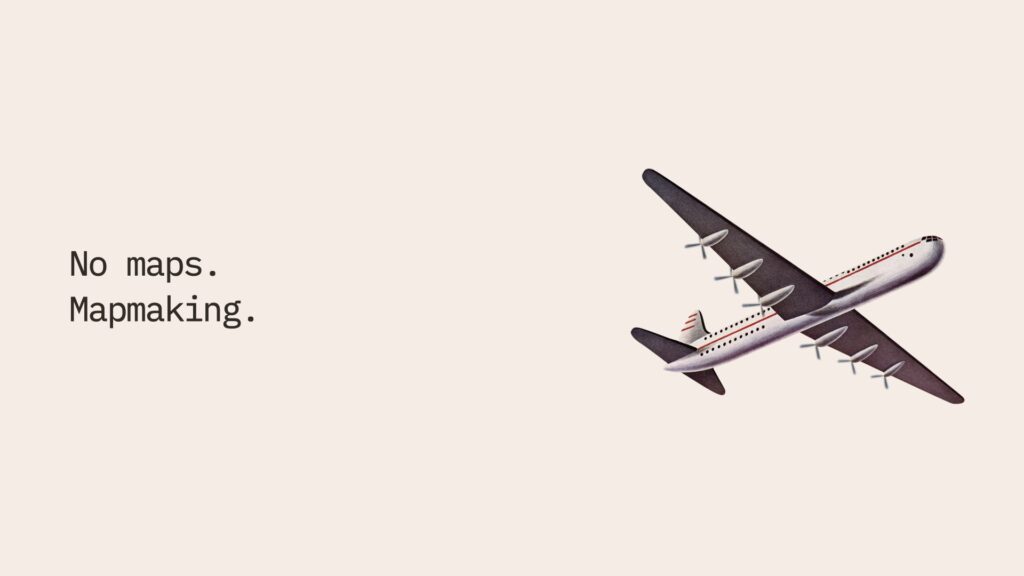
This is the new skill every one of us have to learn it.
Here’s what mapmaking means for your career: Instead of following someone else’s blueprint for success, you create your own. Instead of copying what worked for others, you develop your own methodology based on your unique strengths and insights.
My $100K Lesson in Following Maps
I’m no stranger to making mistakes and loving frameworks. Even just two and a half years ago, I thought the solution to all my problems was building a marketing funnel. Not just any funnel—a copy-paste marketing funnel that worked.
I joined Jonathan Courtney’s brilliant facilitation program at AJ&Smart. The program was excellent—regular calls, courses, community. As I participated, I thought: “I want to offer this to my clients too.”
Nothing wrong with that. But then I thought: “I don’t just want to offer a program. I want to sell people exactly how Jonathan sold me.”
I asked for permission. Jonathan said yes, he’d help, but warned: “Don’t do it. It’s going to be super hard.”
I heard encouragement.
So I built everything. Video sales letter, landing page, ad campaigns. Here were my cringe headlines:
- “90 Days to Talk Like a Boss”
- “The 8+8 Framework”
- “From Boss to Leader in 90 Days”
I was copying something that worked—with permission—so how innocent could that be?
It wasn’t innocent at all.
Here’s what went wrong and why it always goes wrong: I completely moved my attention from my craft as a coach to the marketing. This paint-by-numbers framework meant when you connect dots 1, 2, 3, 4, 5, 6, you always get the same shape.
My offer—deeply personal, based on two decades of discovery—lost all power. Everything became oversimplified because this Russell Brunson-style funnel was imposed on top of me.
I spent two years on operational tasks: running ads, editing videos, scripting VSLs, creating landing pages, measuring conversions, dealing with pixels. I completely lost the big picture of what I was doing and why.
I invested over $100K in ads. At peak performance, I had a 2-to-1 ROI. When I factored in all my work, real performance was around 150% ROI. That means you’re making zero—cash flowing in, cash flowing out, but you’re not really running a business.
It burned me out and didn’t make enough money to sustain itself.
What I did: I refocused on my craft. And the craft became my marketing.
Instead of trying to solve the problem with a framework, I stopped solving the problem and the problem solved itself.
More Renaissance Stories
The same pattern happens with my clients:
Frank works inside a big corporation. He was following the rules. He stopped following the rules, became an entrepreneur. Now he’s thriving.
Sophie was already an entrepreneur, building a SaaS company, but her heart wasn’t in it. All we needed was to tap into her intuition—she calls it her inner compass. Now she’s not building a SaaS business. She’s building a movement, a sisterhood of powerful women.
You can see the pattern: Following orders → becoming an entrepreneur. SaaS business → sisterhood of powerful women. Funnel → focusing on craft.
The lesson: When you stop trying to solve the problem with external frameworks and start listening to your internal wisdom, problems often solve themselves. But this requires courage to trust your own judgment over proven systems.
Becoming More Human
I’m worried about what’s going to happen, but I have certainty about one aspect of the market where I exist: stuff we do in person is going to be more important in the future.
If I were to give investment advice: invest in conferences. Invest in retreats—whether Pilates, business, or ayahuasca, equally important. Services to the person.
We’re going to try to become more human because the machine is so good at output. The exercise left for us: be more ourselves.
The way I’m solving this is having an elevated experience with my clients. This is my farm in Brandenburg, the garden where I meet with clients. We sip green tea and ask each other hard questions.

I don’t think this can be automated, changed, or optimized. It’s not about output—it’s about great input, great questions.
For your business, this means: What’s the irreplaceably human element of what you do? What requires presence, intuition, emotional intelligence that can’t be replicated? That’s where your future value lies.
Learning from H.R. Giger
Let me give you an example from the art world. H.R. Giger won an Oscar for creating the Alien monster.
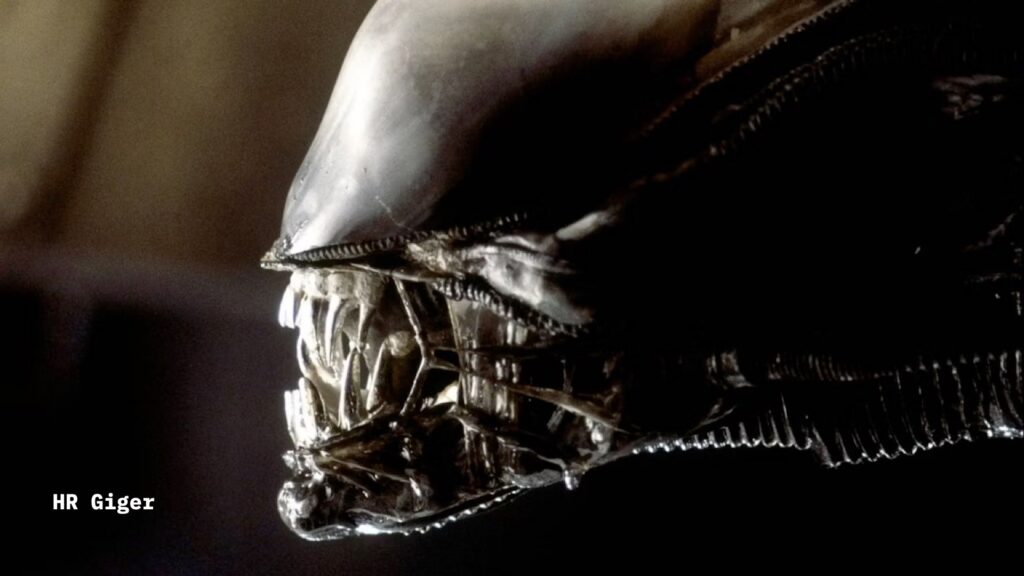
I recently visited the Giger museum in Switzerland—an entire world created by the artist himself while he was still living. Extraordinary sculptures, meeting rooms for aliens, bars with his biomechanical furniture.
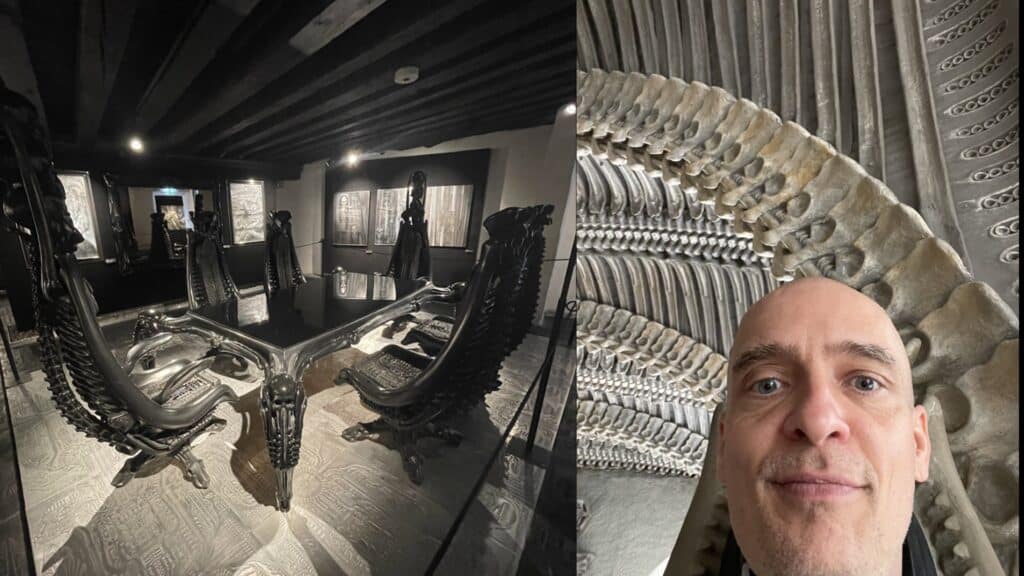
Giger never intended to create beautiful art. He always thought to picture his nightmares, his worst nightmares.
Imagine if this extraordinary artist had followed the “good artist framework” of the seventies. What’s hot? Neon colors, floral patterns. Imagine if he’d asked for permission to picture aliens or anything evocative.
That would have been a disaster.
We all need to learn to be more like Giger. Work from inside-out. Giger was painting his nightmares—his most authentic, uncomfortable truths.
What are you avoiding in your work? What feels too personal, too weird, too risky to share? That might be exactly what makes you irreplaceable.
The New Priority System
Rick Rubin gives us a guide for these complicated times in The Creative Act:
“In terms of priority, inspiration comes first. You come next. The audience comes last. The work reveals itself as you go.”
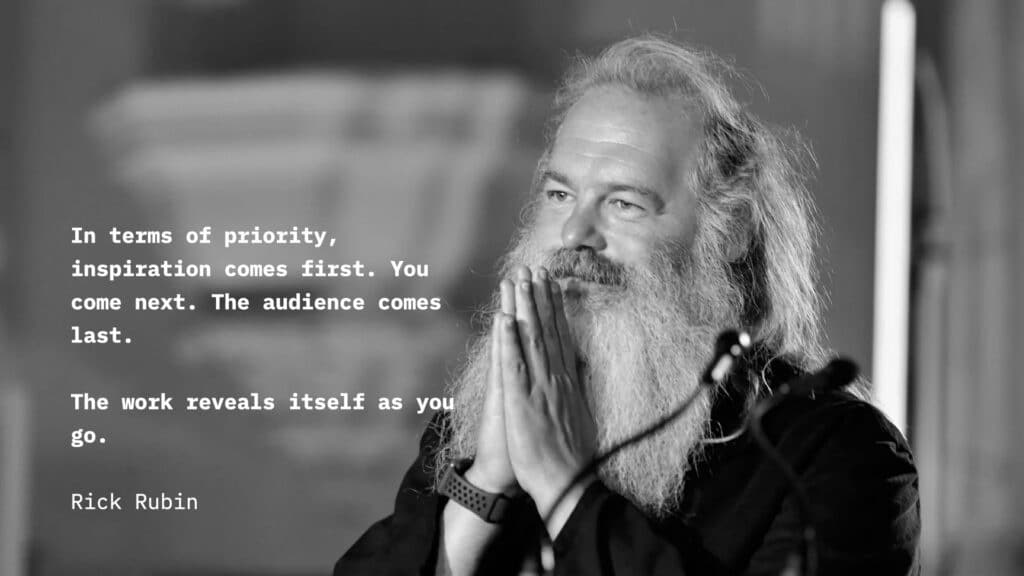
If this was a traditional business framework, the audience would be first, messaging second, inspiration last. This is a completely different world.
What this means for your business: Stop starting with market research and competitor analysis. Start with what genuinely inspires you, what you’re uniquely positioned to see or solve. The market will respond to authentic conviction better than manufactured positioning.
Where to Start Your Renaissance
“Where do I start?” you might ask.
Start by slowing down. It’s challenging because we’re in hustle mode—new proposals, LinkedIn posts, newsletters, client requests.
Carve out 15 minutes a day without input. Make it 30 minutes. An hour. Early morning, before picking up your phone. Make listening to yourself a priority.
The moment your brain says “you’re about to enter the cave you fear to enter,” we immediately compensate with our phones, social media, anything to avoid discomfort. Entire product teams exploit how our brains work. It’s supposed to be hard.
I devoted an entire talk just to this subject.
Find your own way of getting bored. Once you’re bored, endure it. After silence, after lack of input, something will emerge. That’s your mapmaking ability.
For some people it’s rock climbing, Pilates, meditation. Every solution is individual, but the principle is universal: create space for your inner voice to emerge.
Years That Answer
Zora Neale Hurston wrote: “There are years that ask questions and years that answer.”
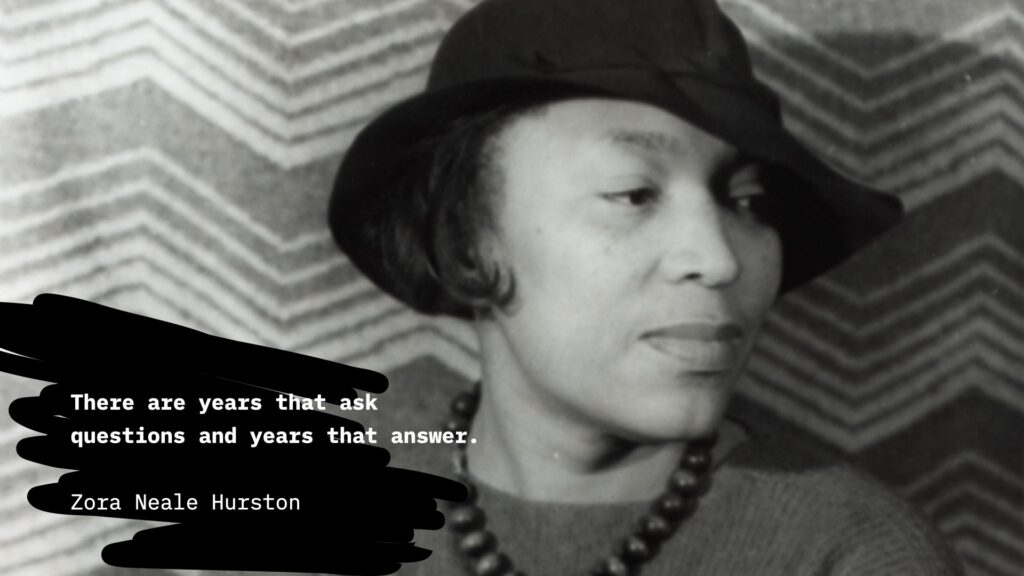
I think we live in years that ask questions. But if we enter that cave, with all the discomfort it requires, if we do the work from inside-out and tap into our intuition, whatever that means for each of us, we can quickly become the years that answer.
We can go from malaise to renaissance.
But first, we have to stop running from the discomfort. We have to learn to be bored. We have to trust that our authentic voice, our unique perspective, our irreplaceable humanness is exactly what the world needs as machines take over the mechanical work.
Your renaissance is waiting on the other side of that cave.
Ready to stop following frameworks and start creating your own path? I work with founders and executives who want to transform their relationship with chaos and uncertainty. Discover my coaching approach here and let’s explore what your renaissance might look like.

